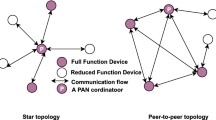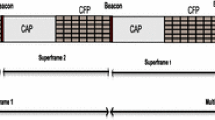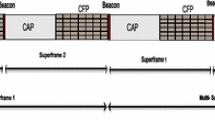Abstract
The IEEE 802.15.4 is a well-known standard that is widely utilized for Wireless Sensor Networks due to its low rate and energy efficiency. A novel amendment IEEE 802.15.4k is released for the support of the requirements of critical infrastructure monitoring applications. It is intended to deal with priority packet using the Priority Channel Access (PCA). In this paper, we introduce a new IEEE 802.15.4k protocol through embedding Markov chain models, namely a two dimensional Markov chain model for the IEEE 802.15.4k slotted CSMA/CA with PCA backoff access channel mechanism for priority packet transmission and a three dimensional Markov chain model for the IEEE 802.15.4k CSMA/CA access channel mechanism for non priority packet transmission. Our new model takes into account retry limits, acknowledgment mechanisms, transmission errors and saturated traffic. Furthermore, to test and validate the developed protocol a detailed mathematical expressions of the reliability, power consumption, average delay for successful packet transmission and throughput are given in order to compare the performance of both mechanisms. Moreover parameters that significantly influence on the performance of the network such as network size, Bit Error Rate, packet length and probability that the available packet is priority are analyzed to determine their impact. The obtained numerical results show that a higher reliability, lower throughput, negligible power consumption and lower delay are observed in our new protocol due to the priority channel access instead of the ordinary channel access. Additionally, we conduct a comparative study between our new IEEE 802.15.4k CSMA/CA mechanism and the IEEE 802.15.4 CSMA/CA mechanism. To the best of our knowledge, this is the first work modeling the 802.15.4k mechanisms and evaluating theirs performance under fading channel.










Similar content being viewed by others
References
Ajaz, A. K., & Mrs Himani, A. (2016). A survey paper on applications and challenges in wireless sensor network. International Journal of Innovative Research in Science, 5(1), 607–614.
Ishfaq, A., Khalil, S., & Saif, U. (2016). Military applications using wireless sensor networks: A survey. International Journal of Engineering Science and Computing, 6(6), 7039–7043.
Zubiete, E. D., Luque, L. F., Rodriguez, A. V. M., & Gonzalez, I. G. (2011). Review of wireless sensors networks in health applications. In The annual international conference of the IEEE engineering in medicine and biology society, pp. 1789–1793.
Ashwini, R. M., & Pooja, M. (2014). Application of wireless sensor network in home automation. International Journal of Computer & Organization Trends, 4(3), 64–71.
Ramson, S. R. J. & Moni, D. J. (2017). Applications of wireless sensor networks: A survey. In IEEE international conference on innovations in electrical, electronics, instrumentation and media technology ICIEEIMT, pp. 325–329.
Zhao, J. (2011). Wireless sensor networks for industrial process monitoring and control: A survey. Network Protocols and Algorithms, 3(1), 46–63.
IEEE Std 802.15.4-2003. (2003). Part 15.4: Wireless medium access control (MAC) and physical layer (PHY) specifications for low-rate wireless area sensor networks (WPANs).
IEEE Std 802.15.4-2011. (2011). Part 15.4: Low-rate wireless personal area networks (WPANs) (revision of IEEE std 802.15.4-2006).
IEEE Std 802.15.4a. (2007). Part 15.4: Wireless medium access control (MAC) and physical layer (PHY) specifications for low-rate wireless personal area networks (WPANs) Amendment 1: Add alternate PHYs (Amendment to IEEE Std 802.15.4-2006).
IEEE 802.15.4c. (2009). Part 15.4: Wireless medium access control (MAC) and physical layer (PHY) specifications for low-rate wireless personal area networks (WPANs) Amendment 2: Alternative physical layer extension to support one or more of the Chinese 314–316 MHz, 430–434 MHz, and 779–787 MHz bands (Amendment to IEEE Std 802.15.4-2006).
IEEE 802.15.4d. (2009). Part 15.4: Wireless medium access control (MAC) and physical layer (PHY) specifications for low-rate wireless personal area networks (WPANs) Amendment 3: Alternative physical layer extension to support the Japanese 950 MHz bands (Amendment to IEEE Std 802.15.4-2006).
IEEE Std 802.15.4f. (2012). Part 15.4: Low-rate wireless personal area networks (LR-WPANs) Amendment 2: Active radio frequency identification (RFID) system physical layer (PHY) (Amendment to IEEE Std 802.15.4-2011).
IEEE Std 802.15.4g. (2012). Part 15.4: Low-rate wireless personal area networks (LR-WPANs) amendment 3: Physical layer (PHY) specifications for low-data-rate, wireless, smart metering utility networks (Amendment to IEEE Std 802.15.4-2011).
IEEE Std 802.15.4j. (2013). Part 15.4: Low-rate wireless personal area networks (LR-WPANs) amendment 4: Alternative physical layer extension to support medical body area network (MBAN) services operating in the 2360–2400 MHz band (amendment to IEEE Std 802.15.4-2011).
IEEE Std 802.15.4-2006. (2006). Part 15.4: Wireless medium access control (MAC) and physical layer (PHY) specifications for low-rate wireless personal area networks (WPANs) (revision of IEEE std 802.15.4-2003).
IEEE Std 802.15.4-2015. (2015). IEEE standard for low-rate wireless personal area networks WPANs (revision of IEEE Std 802.15.4-2011).
IEEE Std 802.15.4e. (2012). Part 15.4: Low-rate wireless personal area networks (LR-WPANs) amendment 1: MAC sublayer (Amendment to IEEE Std 802.15.4-2011).
Ouanteur, C., Bouallouche-Medjkoune, L., & Aïssani, D. (2017). An enhanced analytical model and performance evaluation of the IEEE 80.21.54e TSCH CA. Wireless Personal Communications, 96(1), 1355–1376.
IEEE Std 802.15.4k. (2013). Part 15.4: Low-rate wireless personal area networks (LR-WPANs) amendment 5: Physical layer specifications for low energy, critical infrastructure monitoring networks(amendment to IEEE Std 802.15.4-2011).D
Vidács, A., & Vida, R. (2015). Wireless sensor network based technologies for critical infrastructure systems. Springer, Berlin, pp. 301–316.
Gebremedhin, B. G., Haapola, J. & Iinatti, J. (2015). Performance evaluation of IEEE 802.15.4k priority channel access with DSSS PHY. In European wireless, pp. 368–373.
Zhu, J., Tao, Z., & Lv, C. (2012). Performance evaluation of IEEE 80.21.54 CSMA/CA scheme adopting a modified LIB model. Wireless Personal Communications, 65(1), 25–51.
Bianchi, G. (2000). Performance analysis of the IEEE 802.11 distributed coordination function. IEEE Journal on Selected Areas in Communication, 18(3), 535–547.
Mišić J., Mišić V. B. & Shafi S. (2004). Performance of IEEE 802.15.4 beacon enabled PAN with uplink transmissions in non-saturation mode-access delay for finite buffers. In First international conference on broadband networks, pp. 416–425.
Park, T. R., Kim, T. H., Choi, J. Y., Choi, S., & Kwon, W. H. (2005). Throughput and energy consumption analysis of IEEE 80.21.54 slotted CSMA/CA. Electronics Letters, 41(18), 1–2.
Sahoo, P. K. & Sheu, J-P. (2008). Modeling IEEE 802.15.4 based wireless sensor network with packet retry limits. In The 5th ACM symposium, pp. 63–70.
Pollin, S., Ergen, M., Ergen, S. C., Bougard, B., Van der Perre, L., Moerman, I., et al. (2008). Performance analysis of slotted carrier sense IEEE 802.15.4 medium access layer. IEEE Transactions on Wireless Communications, 7(9), 3359–3371.
Park, P., Di Marco, P., Soldati, P., Fischione, C. & Johansson K.H. (2009). A generalized markov chain model for effective analysis of slotted IEEE 802.15.4. In IEEE 6th international conference on mobile adhoc and sensor systems, pp. 130–139.
Park, P., Di Marco, P., Fischione, C., & Johansson, K. H. (2013). Modeling and stability analysis of hybrid multiple access in the IEEE 802.15.4 protocol. ACM Transactions on Sensor Networks (TOSN), 24(3), 550–564.
Atmani, M., Aïssani, D., & Hadjadj-Aoul, Y. (2018). Towards bandwidth and energy optimization in IEEE 802.15.4 wireless sensor networks. Computing, 100(6), 597–620.
Kiran, M. P. R. S., & Rajalakshmi, P. (2018). Performance analysis of CSMA/CA and PCA for time critical industrial IoT applications. IEEE Transactions on Industrial Informatics, 14(5), 1–12.
Bachiri, L., Aïssani, D., & Bouallouche-Medjkoune, L. (2014). Saturation throughput analysis of the IEEE 802.11e EDCA network with contention free burst under fading channel. Wireless Personal Communications, 79(1), 545–564.
Yazid, M., Bouallouche-Medjkoune, L., Aïssani, D., Amrouche, N., & Bakli, K. (2013). Analytical analysis of applying packet fragmentation mechanism on both basic and RTS/CTS access methods of the IEEE 80.211b DCF network under imperfect channel and finite load conditions. Wireless Personal Communications, 77(1), 477–506.
Author information
Authors and Affiliations
Corresponding author
Additional information
Publisher's Note
Springer Nature remains neutral with regard to jurisdictional claims in published maps and institutional affiliations.
Rights and permissions
About this article
Cite this article
Alkama, L., Bouallouche-Medjkoune, L. & Bachiri, L. Modeling and Performance Evaluation of the IEEE 802.15.4K CSMA/CA with Priority Channel Access Mechanism Under Fading Channel. Wireless Pers Commun 115, 527–556 (2020). https://doi.org/10.1007/s11277-020-07584-9
Published:
Issue Date:
DOI: https://doi.org/10.1007/s11277-020-07584-9




